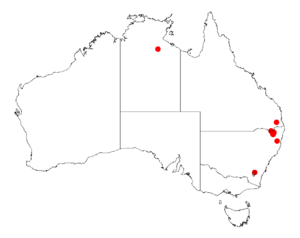Bolivia wattle facts for kids
Quick facts for kids Bolivia wattle |
|
|---|---|
| Scientific classification | |
| Genus: |
Acacia
|
| Species: |
pycnostachya
|
 |
|
| Occurrence data from AVH | |
The Bolivia wattle (scientific name: Acacia pycnostachya) is a type of shrub or small tree. It belongs to the Acacia family, which is a large group of plants. You can find this plant growing naturally in eastern Australia.
What Does It Look Like?
The Bolivia wattle usually grows into a shrub or a small tree. It can reach a height of up to 7 m (23 ft), which is about as tall as a two-story building. Often, the plant is covered with a fine white powder, giving it a unique look.
Branches and "Leaves"
The branches of the Bolivia wattle are thick and flat. They can be between 3.5 and 11 mm (0.14 and 0.43 in) wide. Their color can vary, from purplish to brown-orange or tan. These branches are also covered in that fine white powder.
Like many Acacia species, the Bolivia wattle doesn't have true leaves. Instead, it has special flattened stems called phyllodes. These phyllodes do the job of leaves. They are smooth, stiff, and feel a bit like leather. They have a shape that is narrow and pointed, like a spearhead, or wider and egg-shaped. Each phyllode is about 6 to 11.5 cm (2.4 to 4.5 in) long and 10 to 27 mm (0.39 to 1.06 in) wide. You can see three main veins that stand out more than the others.
Flowers and Seeds
The Bolivia wattle blooms, or flowers, between August and October. During this time, it produces beautiful golden flowers. These flowers grow in dense clusters on spikes that are 2.5 to 7.5 cm (0.98 to 2.95 in) long. The spikes are attached directly to the stem without a stalk.
After the flowers, seed pods begin to form. These pods are long and thin, like a line. They are squeezed in between each seed, making them look a bit bumpy. The pods are typically 8 to 12 cm (3.1 to 4.7 in) long and 2 to 4.5 mm (0.079 to 0.177 in) wide. They have wrinkles running along their length and pale edges. Inside these pods, you'll find black seeds. The seeds are oblong, meaning they are longer than they are wide, and are about 4 to 6 mm (0.16 to 0.24 in) long. They are arranged lengthwise inside the pod.
Where Does It Grow?
The Bolivia wattle is a plant that is endemic to a specific area. This means it only grows naturally in one particular place in the world. For the Bolivia wattle, that place is the very northeastern part of New South Wales in Australia.
You can find it in the Bolivia Range, which is in the northern tablelands. This area is right on the border with Queensland. The plant prefers to grow on granite slopes, often among large rocks or boulders. It likes sandy soil and is part of dry heath and Eucalyptus and Callitris woodland communities.

